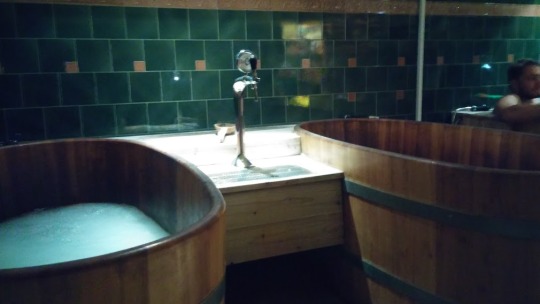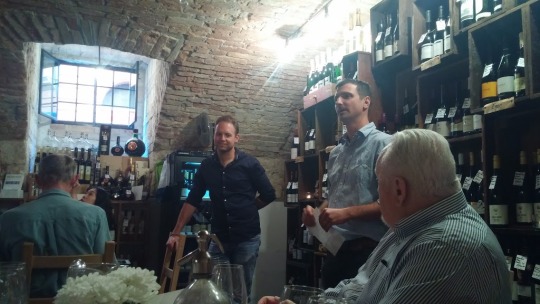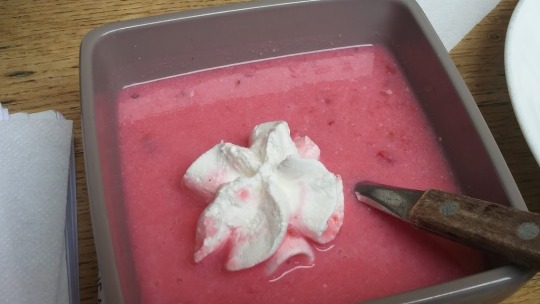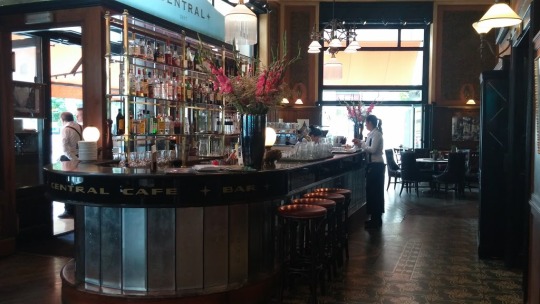#and now that winter’s started it’s a really good time for soups and goulash with dumplings
Text
finally found and ordered a copy of the czech cookbook my mum has so that I’ll be able to try out more recipes
#kay speaks#sad that i’m this excited about a cookbook#but i’ve been wanting to cook more czech food for a while now#and now that winter’s started it’s a really good time for soups and goulash with dumplings#i’m already making pork with dumplings and cabbage tonight and i’m so excited i hope i don’t fuck it up
2 notes
·
View notes
Photo

Food, Glorious Food (and drink) July 13 and 14
Well this has been a week of self-indulgence from beer baths at the Széchenyi Spa to a Tasting Table dinner to sample wines from the Csopak wine region near Lake Balaton (and eat food that pairs well with it), to a 4-hour gastronomic food walk on the Pest side of the Danube.
The Beer Spa


Thursday afternoon, I went with friends to the Széchenyi Thermal Baths near the City Park (Városliget) where I have been so many times in my 14 years coming to Hungary, but I wanted to check out the recently opened Beer Spa, which I had read about and posted about on Facebook. I interviewed Olivér Szarvas, the proprietor who brought the beer spa to Széchenyi, after seeing similar set-ups in the Czech Republic. He arranged to rent space in the bathhouse and after you pay to get into the facility, which is a bit steep even for half a day (about $20 plus extras -- like a cabana, towels, massage, etc.), you will see a sign and a representative in the lobby for the Beer Spa. She will lead you up a flight of stairs to the beer spa entrance, where you pay another fee depending upon the number of people and the number of wooden tubs (each fits two adults) you want. Estimate it to be about 20- 25 Euro extra per person. That gets you unlimited draught beer for the 45-minute session, and since we had some non-drinkers (I tried the beer, but I am not a beer drinker), we also had an interesting pomagranate flavored sparkling beverage. I won’t say soda, because it was almost cider-like. Before we went in, they showed us what they would put into the tubs--malt, hops,bath salts, and yeast--which made the water whitish at first but it soon turned clear. After we all got into the tubs, which were lukewarm, not hot, the hostess brought us zsiros kenyer, bread with fat, salt and paprika on it, which is a traditional Hungarian snack, that makes you thirstier, but I guess it goes well with beer. It tasted too salty for me, but the pomegranate drink tempered the saltiness. The beer spa can be booked ahead online and, as my friend said, could be a nice way to spend an afternoon or evening with co-worker, friends, or a date. Well, co-workers would have to be good friends to share a hot tub together, but maybe even a pre-wedding celebration. More later on the rest of the spa experience, which is somewhat different from the Rudas bathhouse. Find out more at thermalbeerspa.com.
Tasting Table--Wine Tasting with Dinner



After working up an appetite spending the afternoon at the thermal baths following the beer spa, I was invited by my friend Gabor Banfalvi to a wine tasting and dinner at his company’s establishment, the Tasting Table. He and his American wife, Carolyn, whom I met at her book signing in New York for Food & Wine Budapest, own a company called Taste Hungary. It started out as a tour company when someone asked them for help in arranging a simple tour of a food-related location, and they soon grew their business into a number of food and wine tours, high-end tours (like spa and winery tours), and custom tours, which I worked on with them in 2014. (I brought a group of Agricultural Business students to Hungary to learn about the agriculture, viticulture and culinary businesses and policies). Taste Hungary opened their Tasting Table location behind the National Museum (on Brody Sandor utca) where they offer biweekly Thursday night wine tasting dinners, and sell wines, gift paprika, books on wine and food in Hungary, and offer wine tastings to guests on their food tours at the culimination of the day. The room is in a lower-level room with vaulted brick ceilings reminiscent of a wine cellar, and the windows are close to the ceiling at sidewalk level. Simple, clean wooden tables and chairs fill the room with the modern kitchen and pouring table at the front of the room near the entrance.
The dinner this week featured wines from the Csopak region on the northern shore of Lake Balaton. It is a region of small family run wineries, mostly, and their special varietals are Olaszrizling (which translates to Italian riesling, but is actually Welsh Reisling varietal), Furmint (a dry wine made with the same grapes used in world-renown Tokaji dessert wines)--both of which are white wines--and Kékfrankos, the most widespread red wine in the area, which is also produced in neighboring Austria as Blau Frankisch. We learned about the terroir of the region and the difference between Csopaki and Tokaji Furmints. We got to taste the wines and enjoy them with peach soup, trout with mushrooms and spinach, and a summer fruit clafouty dessert. I shared my table with U.S. Embassy staffers--one couple outgoing and one incoming. Each week is a different theme, and the meals are designed around the wines, being cooked as the guests are arriving.
Taste Hungary will open a retail wine shop across the street from their Tasting Table location, and Gabor is investigating possibilities for opening another retail shop in Washington, D.C. With the international community, embassies, and visitors to that area, a Hungarian wine shop would be most likely to succeed, as they probably know more about these varietals than most Americans, who are not as knowledgeable or interested in Hungarian wines yet.
If in Budapest, for an introduction to and lesson on quality wines from the country’s 22 regions (and craft beers), as well as a small but interesting selection of wines and food products to buy, check out the Tasting Room, in walking distance to the Astoria station on the M2 Metro line. http://tastingtablebudapest.com/

Food on your Feet
After my dinner at Tasting Table, Gabor invited me to take a couple of tours--a food tour and a sightseeing tour. The food tour was the next MORNING, and I was still full from the dinner and wine tasting the night before, so I suggest, since the Pest food walk is offered almost daily, to take it on a day when you are hungry and ready for walking.
This was honestly more food and drink and learning than I ever expected a food tour to be. A group of four of us met at the entrance to the famous, and now tourist-friendly Vasarcsarnok -- Central Market--in Kalvin Ter. We were met by Hannah, a PhD student in history and antiquities, who started us off with Unicom, the Hungarian liquer, which is traditionally used to prepare the stomach for digestion. On to the food vendors for a shared langos (lest we fill up on fried dought, cheese and sour cream). We wandered through the marketplace and saw the different food vendors, including the vegetable and meat vendors and fish mongers in the lower level. We tried a selection of salami--which included horse meat, deer meat, mangalica pig, ham, and winter sausage--the creme-de-la-creme of sausage that is the only one that does not use paprika in the making. It is what Hungarians enjoy eating for special occasions, and it was actually quite delicious. From there we had a selection of pickled vegetables, including the normal gherkins, but miniature watermelons (my grandmother used to pickle watermelon rinds, but these were almost the size of kiwis), garlic cloves--which took away the bite of the raw garlic, cauliflower, and peppers. Hungarians love their pickled peppers. These were from Vecses, the primary area for pickled vegetables made by Marika from a family recipe. Traditional Hungarians believe that pickled vegetables and sauerkraut are good for digestion, and there may be something to the pro-biotic effects of the vinegar used.
From there we left the building and walked to Rozsavölgyi Csokoládé shop, an award-winning chocolatier where we each got to choose two pieces of handmade, uniquely flavored chocolate--they included choices of coffee and balsamic vinegar chocolate, Earl Grey, orange balsamic, smoked wood, cardamom, and sour cherry raspberry among others. The taste was so velvety smooth and decadent--just a perfect balance of bitter, sweet, and cocoa that you don’t easily find just anywhere, and that is so satisfying you really learn to appreciate the possibilities of how good food can be when prepared right.



In addition to the handmade individual chocolates for sale, there were shelves of exquisitely packaged gift chocolates, which Hannah said were made with the bean-to-bar method, meaning, the chocolatiers here buy their own coca beans and prepare the chocolate from scratch--directly from the bean themselves, before making each bar. Hungarian chocolatiers are winning international chocolate competitions, and I think it is a good idea to try them out before they become too well-known as the treasure that they are. A Madison Avenue, NYC, shop would do well to include these. http://www.rozsavolgyi.com


The next round was lunch near the law school and literature school of the ELTE university. We stood outside at a table at Belvarosi Dizsnotoros eating liver and paprika sausages, duck legs, red cabbage, lecso --a tomato, onion and pepper mixture-homemade potatoe chips, freshly grated horseradish and mustard, along with soups. I had cold red currant soup and the one gentleman with us had goulash soup. I’m not big on eating sausage, but this was actually all tasty and filling and a great, quick lunch. Hannah, our guide, said that the duck leg was a tradition with Jewish settlers to the area who took on Hungarian culinary traditions but did not want to have the sausage, but wanted some kind of fatty meat that would have the same kind of texture and experience of a Hungarian meal. She also suggested we mix the freshly grated horseradish in with the red cabbage and eat it with the duck, and yes, it was a delicious combination.
http://belvarosidisznotoros.hu
The Central Kavehaz




I was thrilled when Hannah brought us to the Central Kavehaz near the Elizabeth Bridge for dessert. The kavehaz turned 130 years old this year and I had not been there since 2004 or so. It looked lovelier than I remembered it and there was music--a piano player--by the entrance. They do offer meals, which I believe are primarily on the upper level, but I may be wrong. We sat directly in front of the cake display and chose to share four different types of cake among the lot of us--dobos torte, Eszterhazy torte, turos cake with merengue and apricots and a chocolate mousse cake called Opera Cake. We all ordered cappucino, which was a good pairing, but the coffee, tea, hot chocolate and other beverage selection was substantial.
The different coffeehouses in Budapest attracted writers who were often not making much money and could not pay the heating bills. So they went to the cafe to stay warm and to meet potential publishers of their work. Sometimes, Hannah said, the writers would write a poem to cover the cost of the meal and the waiter would take the poem and sell it to a publisher, and bring the change to the writer. So the waiters were kind of literary agents on behalf of the writers. Hannah also said that popular actresses of the time would come in to meet the writers in hopes of having a play written for them to perform in, and those actresses drew in young female fans. The young women then attracted young men, so it was a win-win situation for the writers, the kavehaz and the other guests as well. During the Soviet time, the coffeehouse culture was “discouraged,” because there was too much political discussion going on among coffeehouse guests. Presszo bars were the replacement--small establishments to drink a quick coffee or beer. Those still exist as well.
Our final stop was the Tasting Table where we had an assortment of wines to try. We were given a 10% discount if we bought any of the wines they sell. Interestingly, on my trip to the ladies room, I saw a box holding the paper towels that read “St. Andrea.” I remembered that St. Andrea was a winery that produced a lovely white wine called Napbor (day wine). So I went out, looked at the shelves and found a nice bottle of Napbor to bring home with me.
Wonderful way to spend four hours, eating, drinking, learning and meeting other visitors to Budapest.
#tastingtable#budapest#vasarcsarnok#langos#unicum#pickles#wintersausage#salami#ducklegs#liver sausage#centralkavehaz#dobos torte#eszterhazy#turos#merengue#apricot jam#Napbor#standrea
0 notes